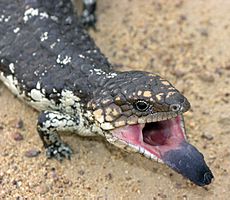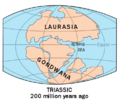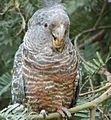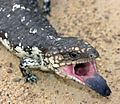Fauna of Australia facts for kids

Australia is home to an amazing variety of animals! Many of them are found nowhere else in the world. About 46% of birds, 69% of mammals, 94% of amphibians, and 93% of reptiles live only in Australia. This is because Australia has been separated from other continents for a very long time.
A special thing about Australia's animals is how few native placental mammals there are. Instead, marsupials are very common. Marsupials are mammals that carry their babies in a pouch. This group includes kangaroos, possums, and quolls. These marsupials fill many of the same roles that placental mammals do in other parts of the world. Australia also has two of the five known types of monotremes, which are mammals that lay eggs!
Australia is also famous for its many venomous animals. These include the platypus, spiders, scorpions, octopus, jellyfish, and many types of snakes. In fact, Australia has more venomous snake species than non-venomous ones!
People have lived in Australia for a very long time. Indigenous Australians arrived between 48,000 and 70,000 years ago. Europeans started settling in 1788. Both groups have changed Australia's animals. Hunting, bringing in new animals, and changing habitats have caused many animals to disappear. About 33 types of mammals, 24 birds, one reptile, and three frog species are believed to have become extinct since Europeans arrived. Today, people are working hard to protect Australia's unique wildlife.
Contents
How Australia's Animals Became Unique

Australia's unique animals are a result of its long history and changing climate. Long ago, Australia was part of a giant supercontinent called Gondwana. This continent also included South America, Africa, India, and Antarctica.
Around 140 million years ago, Gondwana started to break apart. About 50 million years ago, Australia separated from Antarctica. For a very long time, Australia drifted alone. This isolation helped its unique animals, like marsupials, to survive and evolve without much competition from animals found elsewhere.
Later, about 5.3 million years ago, Australia moved closer to Asia. This allowed some Asian animals, especially birds, to arrive. However, a natural boundary called the Wallace Line kept most Asian and Australian animals separate. As Australia moved, its climate became much drier. This led to many animals adapting to dry conditions, while others thrived in wet tropical areas.
Amazing Mammals of Australia
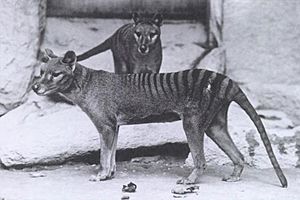
Australia has a fascinating history of mammals, with many unique species still living today. The fossil record shows that monotremes have been in Australia for a very long time, since the Early Cretaceous period (145–99 million years ago). Marsupials and placental mammals appeared later, around 56–34 million years ago.
Even though both marsupials and placental mammals lived in Australia long ago, only marsupials survived to the present day as native land animals. Placental mammals, like rodents, only returned to Australia about 5–10 million years ago when Australia moved closer to Indonesia.
Marsupials have evolved to fit many different roles in nature. They often look similar to placental mammals in other parts of the world that do similar jobs. For example, the Tasmanian wolf, Australia's top predator, looked a lot like a dog. Gliding possums are similar to flying squirrels. Most Australian mammals are active at night and many live in trees, so they can be hard to spot!
Monotremes and Marsupials: Pouches and Eggs!
Australia is home to two of the five living species of monotremes: the platypus and the short-beaked echidna. Monotremes are special because they lay eggs instead of giving birth to live young, unlike most other mammals.
The platypus is a truly strange animal. It's a venomous, egg-laying mammal with a duck-like bill. When it was first shown to scientists in England, they thought it was a joke! The short-beaked echidna is covered in hairy spikes. It has a long, tubular snout and a tongue that can flick in and out super fast to catch termites.
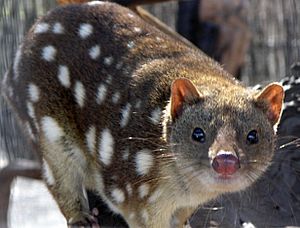
Australia has the most types of marsupials in the world. Marsupials are known for their pouch, where they raise their young.
Meat-eating marsupials, called Dasyuromorphia, include the Dasyuridae family (with 51 members) and the numbat. The Tasmanian tiger was the largest Dasyuromorphia, but it sadly died out in 1936. The biggest meat-eating marsupial alive today is the Tasmanian devil. It's about the size of a small dog and mostly eats dead animals. It used to live on the mainland but now only lives in Tasmania. There are four types of quoll, also called "native cats," and all of them are threatened. Most other Dasyuridae are small, weighing less than 100 grams.
Two types of marsupial mole live in the deserts of Western Australia. These rare, blind, and earless creatures spend most of their lives underground.

Bandicoots and bilbies are marsupial omnivores, meaning they eat both plants and meat. Most of the seven species in Australia are endangered. They have plump bodies, long snouts, big ears, and thin tails.
The Diprotodontia group of marsupials includes the koala and wombats. The koala is a famous tree-dwelling marsupial that eats only eucalyptus leaves. It gets all the water it needs from these leaves. Wombats live on the ground and dig amazing burrow systems. They eat grasses and roots.
The Phalangerida group includes possums and macropods. Possums are diverse tree-dwelling marsupials. They range from tiny, 7-gram little pygmy possums to cat-sized ringtail and brushtail possums. Sugar and squirrel gliders are common gliding possums. They have special skin flaps that let them glide between trees.
Macropods include kangaroos and wallabies. They have large hind legs, long feet, and strong tails for hopping. The smallest macropod is the musky rat-kangaroo, which walks on all fours. The male red kangaroo is the largest, standing about 2 meters tall and weighing up to 85 kg.
Other Mammals: Bats, Rodents, and Marine Life
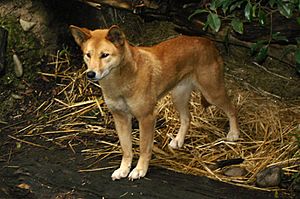
Australia has native placental mammals from two groups: bats and rodents (mice and rats). There are many types of bats, and 7% of the world's bat species live in Australia. Rodents arrived in Australia millions of years ago and have evolved into many unique species.
Since humans settled in Australia, many other placental mammals have been introduced. The dingo was brought by people from the north about 5000 years ago. Europeans later brought animals like the red fox, European hare, and European rabbit. Other farm animals, like cats, horses, and pigs, have also escaped and now live in the wild.
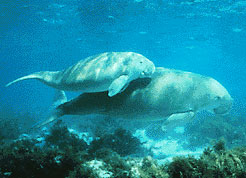
Australia's coastal waters are home to 46 types of marine mammals, including many kinds of whales and oceanic dolphins. Some, like humpback whales, are often seen. The Australian snubfin dolphin was only discovered in 2005!
The dugong is an endangered marine mammal that lives in the warm waters of northern Australia. It can grow up to 3 meters long and weigh 400 kg. Dugongs are the only plant-eating marine mammals in Australia, feeding on sea grass. Protecting their sea grass homes is very important for their survival. Eleven types of seals live off Australia's southern coast.
Amazing Birds of Australia

Australia has about 800 different bird species, and 45% of them are found only here! Some birds, like the flightless ratites (the emu and southern cassowary), have a very ancient history from Gondwana.
Australia is famous for its many parrots, including cockatoos and galahs. One sixth of all the world's parrots live in Australia! The kookaburra is the largest type of kingfisher. It's known for its call, which sounds just like loud human laughter. The Brolga is a unique crane found only in Australia.
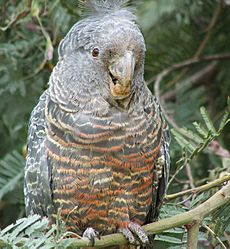
Australia's songbirds, or passerines, include wrens, robins, magpies, honeyeaters, and lyrebirds. The satin bowerbird is very interesting. The male builds a special "bower" and decorates it with blue, shiny items to attract a mate.
Some birds, like swallows and larks, have arrived more recently from Asia. Unfortunately, some birds introduced by humans, like the common starling and Indian mynah, cause problems for native bird species.
About 200 types of seabirds live along Australia's coast. Many of them migrate long distances. Australia is at the end of a major route for migratory water birds, with about two million birds traveling to and from Australia each year. The Australian pelican is a very common large seabird found in most waterways. The Australian little penguin is the only type of penguin that breeds on mainland Australia.
Frogs and Reptiles: From Crocs to Lizards
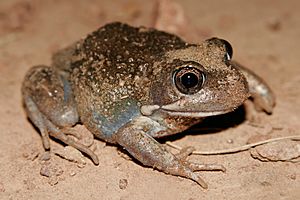
Australia has four families of native frogs and one introduced toad, the cane toad. The cane toad was brought to Australia in 1935 to control pests, but it became a huge problem itself. It spreads across northern Australia, competes with native animals for food, and its poison is dangerous to native wildlife and humans.
The Myobatrachidae, or southern frogs, are Australia's largest frog group. A famous member is the colorful and endangered Corroboree frog. Tree frogs are common in wet areas. Sadly, frog populations in Australia have been declining. This is partly due to a deadly fungal disease called chytridiomycosis.
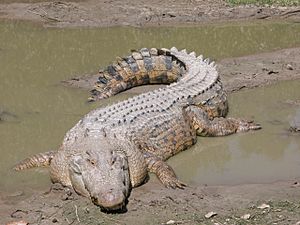
Australia has two types of crocodile. The saltwater crocodile, or "salty," is the largest living crocodile. It can grow over 7 meters long and weigh over 1,000 kg! They live in coastal areas and freshwater rivers in northern Australia. Freshwater crocodiles, found only in northern Australia, are not considered dangerous to humans.
Six types of sea turtle visit Australia's coast, including the flatback and green sea turtles. All of them are protected. Australia also has 35 types of freshwater turtles. The pig-nosed turtle is unique because it's the only Australian turtle not from the main freshwater turtle family. Australia is the only continent without any native land tortoises.
Australia is the only continent where venomous snakes are more common than non-venomous ones! Many of the most venomous snakes in the world, like the fierce snake, eastern brown snake, and eastern tiger snake, live here. There are also 33 types of sea snakes in Australia's northern waters, and many are very venomous.
Luckily for people in cities like Darwin, even though there are many snake species, a smaller number of them are highly venomous compared to other places. This is because there are more harmless pythons and other types of snakes there.

Australia has over 700 species of lizards! There are over 130 types of geckos. The Pygopodidae are a family of legless lizards found only in Australia. Dragon lizards, or Agamidae, include the amazing thorny devil, bearded dragon, and frill-necked lizard.
There are 30 types of monitor lizards, known as goannas, in Australia. The largest is the perentie, which can grow up to 2 meters long. Skinks are the most common lizards, with about 450 species, including the well-known blue-tongued lizards.
Fish: From Reefs to Rivers
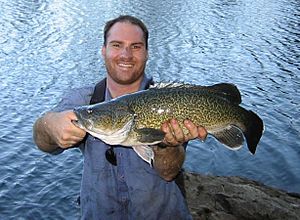
More than 5000 species of fish live in Australia's waters. About 24% of them are found only here. Because Australia doesn't have many large freshwater rivers, it only has about 300 species of freshwater fish.
Some freshwater fish, like the Queensland lungfish, have ancient origins from Gondwana. The salamanderfish is a tiny fish that can survive dry seasons by burying itself in mud. Many of Australia's freshwater fish are related to tropical marine species that have adapted to fresh water. Popular native freshwater fish include the barramundi, Murray cod, and golden perch.
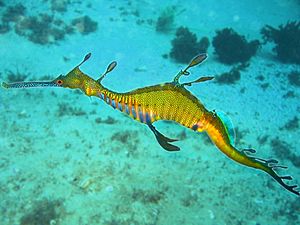
Many non-native freshwater fish have been introduced to Australia, like trout and common carp. Some of these, like the mosquitofish, are very aggressive and harm native fish. Common carp have also caused problems in rivers like the Murray-Darling Basin, making the water muddy and harming native fish and plants.
Most of Australia's fish live in the ocean, especially in tropical waters. The Great Barrier Reef is home to a huge variety of colorful reef fish, such as damselfish, butterflyfish, and angelfish. There are also many venomous fish, like stonefish and pufferfish, whose toxins can be deadly to humans.
Sharks live in all of Australia's coastal waters. There are 166 species, including many types of requiem sharks and wobbegong sharks. Only three species of shark are a significant threat to humans: the bull shark, the tiger shark, and the great white shark. Some popular beaches use shark nets, but these can accidentally harm both dangerous and harmless sharks. Overfishing has also reduced shark numbers, and several species are now endangered.
Incredible Invertebrates
| Taxonomic group | Estimated number of species described | Estimated total number of species in Australia |
|---|---|---|
| Porifera (Sponges) | 1,476 | ~3,500 |
| Cnidaria (Jellyfish, Corals) | 1,705 | ~2,200 |
| Platyhelminthes (Flatworms) | 1,593 | ~10,000 |
| Nematoda (Roundworms) | ~2,060 | ~30,000 |
| Mollusca (Snails, Octopuses) | ~8,700 | ~12,250 |
| Annelida (Segmented Worms) | 2,192 | ~4,230 |
| Crustacea (Crabs, Lobsters) | 7,266 | ~9,500 |
| Arachnida (Spiders, Scorpions) | 6,615 | ~31,338 |
| Insecta (Insects) | ~62,000 | ~205,000 |
| Echinodermata (Starfish, Sea Urchins) | 1,475 | ~2,000 |
| Modified from: Williams et al. 2001 and Chapman, 2009 | ||
Most of Australia's animals are invertebrates, meaning they don't have a backbone. About 96% of Australia's estimated 200,000 animal species are invertebrates! Many of them, like 90% of insects and molluscs, are found only in Australia. Invertebrates are super important for all ecosystems. They help break down dead things, pollinate plants, and are a food source for other animals.
The biggest group of invertebrates is insects, making up 75% of Australia's known animal species. This includes over 28,000 types of beetles, 20,000 types of butterflies and moths, and 14,800 types of ants, bees, and wasps. Some introduced insects, like the red imported fire ant, are a big threat to native species.
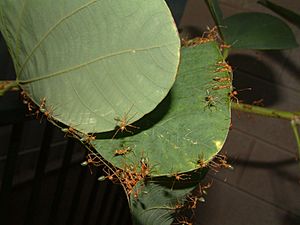
Australia has many types of arachnids, including 78 families of spiders. Some are very venomous, like the famous Sydney funnel-web spider, whose bite can be deadly. The redback spider was once thought to be deadly, but now it's known that antivenom has made bites much safer. There are also thousands of types of mites and ticks, and at least 120 species of scorpions.
In the world of worms, Australia has the giant Gippsland earthworm. This amazing worm is found only in Victoria and can grow up to 3.7 meters long!
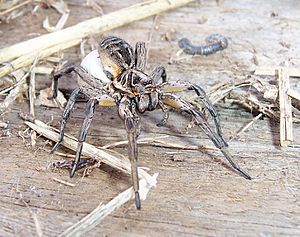
Australia has 124 species of freshwater crayfish. These range from the tiny swamp crayfish, which is less than 30 mm long, to the world's largest crayfish, the Tasmanian giant freshwater crayfish. This giant can measure up to 76 cm long and weigh 4.5 kg! The common yabby is also a type of crayfish found here. Australia also has seven species of freshwater crabs that can survive droughts by plugging their burrows.

The Great Barrier Reef is home to a huge variety of marine invertebrates. These include sea sponges, jellyfish, corals, sea anemones, sea urchins, sea stars, and many types of molluscs like snails, squid, and octopus. Some marine invertebrates are venomous, such as the box jellyfish and the blue-ringed octopus, which can be very dangerous to humans.
The crown-of-thorns starfish can sometimes reproduce too much and eat coral faster than it can grow back, which is a problem for the reef. Other problems come from introduced marine invertebrates like the Asian mussel and the northern Pacific seastar, which take over habitats from native shellfish.
Australia's waters also have many unique marine crustaceans. The warm northern waters have many types of crabs, hermit crabs, lobsters, and prawns. In the colder southern waters, you'll find more amphipods and isopods. Notable species include the Tasmanian giant crab, the second largest crab in the world, weighing up to 13 kg! Australian spiny lobsters are also special because they don't have claws like other lobsters.
Introduced Species: A Big Challenge
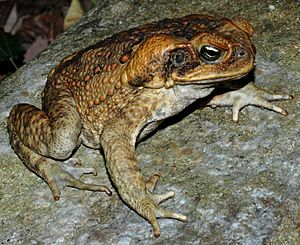
When new animals are brought to Australia, either on purpose or by accident, they can become invasive and cause big problems for the environment. These introduced animals can harm native species in many ways.
For example, rabbits eat so much vegetation that they make land useless. Red foxes hunt and kill native animals. The cane toad poisons predators that try to eat it. Other invasive species include the Indian mynah bird, common carp fish, and the red imported fire ant. These new species compete with native animals for food and habitat.
Controlling these invasive species is very difficult and expensive. It's a major challenge for protecting Australia's amazing biodiversity. A report from 2023 even said that invasive species are the main reason native Australian animals have become extinct since the 1960s.
Protecting Australia's Wildlife
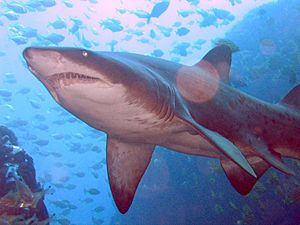
For thousands of years, Australia's animals were very important to Indigenous Australians. They hunted animals like kangaroos, possums, and fish for food and skins. They also used "fire-stick farming," burning parts of the land to help with hunting. This changed the environment and might have helped cause the extinction of some large, ancient animals.
However, the impact of European settlers has been much greater. Since their arrival, hunting, destroying habitats, and introducing new predators and plant-eating animals have led to many extinctions.
Today, much of Australia's wildlife is protected by laws. The federal Environment Protection and Biodiversity Conservation Act 1999 helps identify and protect threatened species. Each state and territory also has its own laws to protect animals. Currently, 380 animal species are listed as endangered or threatened.
Scientists are also working to list and understand all the species in Australia. The Australian Biological Resources Study (ABRS) helps with this research and provides free online databases of Australian plants and animals. It's important to remember that even seemingly safe animals can be dangerous, so understanding Australia's wildlife is key.
The Australian Wildlife Conservancy is a large private group that owns land to protect endangered species. They work hard to prevent extinctions in many important regions across Australia.
Australia is also against commercial whaling and protects all whale species in its waters. It also follows the CITES agreement, which stops the export of endangered species.
Many protected areas, like national parks and reserves, have been created to save Australia's unique ecosystems. These areas cover over 10% of Australia's land. Marine protected zones also cover about 7% of Australia's ocean territory to protect sea life.
Despite these efforts, a 2001 report found that Australia's environment and wildlife management had worsened. Problems like salty land, changing water conditions, land clearing, and invasive species continue to be major challenges for protecting Australia's amazing biodiversity.
Images for kids
-
Evidence suggests that Australia was a part of the supercontinent Gondwana
-
Becoming extinct in 1936, the Tasmanian tiger was the largest carnivorous marsupial to have survived into modern times.
-
The spotted quoll is mainland Australia's largest carnivorous marsupial and an endangered species.
-
The sugar glider
-
The koala does not normally need to drink, because it can obtain all of the moisture it needs by eating leaves.
-
The dingo was the first placental mammal introduced to Australia by humans, around 4000 years ago.
-
The dugong is an endangered species; the largest remaining population is found in Australian waters.
-
The emu is the second largest extant species of bird. It is a heraldic bird, appearing on the coat of arms of Australia.
-
A female gang-gang cockatoo
-
The eastern banjo frog is a common frog species across eastern Australia.
-
The saltwater crocodile is the largest species of crocodile in the world.
-
Blue-tongued lizards are amongst the largest species of skink.
-
There are 30 species of goanna in Australia.
-
The Murray cod is Australia's largest wholly freshwater bony fish.
-
The weedy sea dragon, a fish related to pipefish and seahorses, is found in the waters around southern Australia.
-
The spotted wobbegong is the largest wobbegong shark, reaching a length of around 3 m
-
There are 1,275 described species and subspecies of ant from Australia. These green ants (Oecophylla smaragdina) are found in tropical Australia and build nests in leaves.
-
The wolf spider, Lycosa godeffroyi, is common in many areas of Australia. In this family of spiders, the female carries her egg-sac.
-
A magnificent sea anemone on the Great Barrier Reef, with an ocellaris clownfish.
-
The poisonous cane toad
-
The grey nurse shark is critically endangered on the Australian east coast.
See also
 In Spanish: Fauna de Australia para niños
In Spanish: Fauna de Australia para niños




